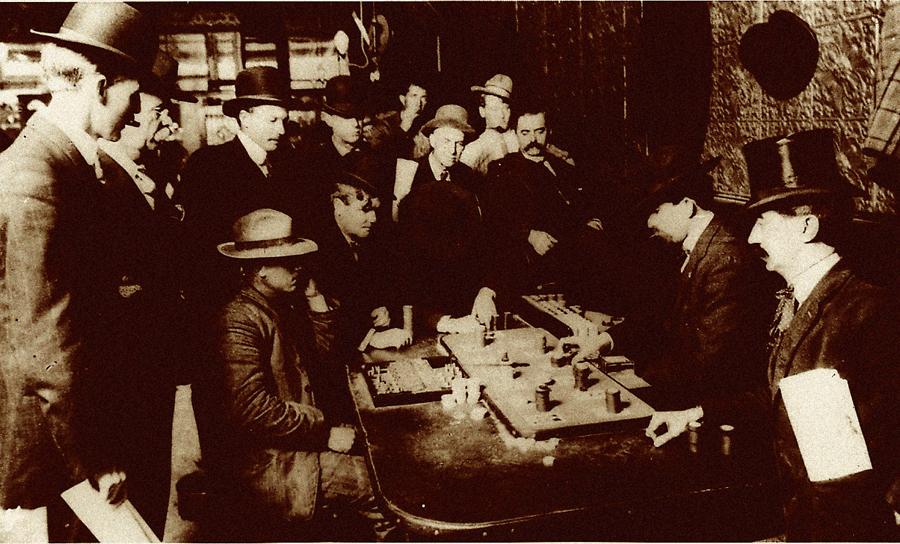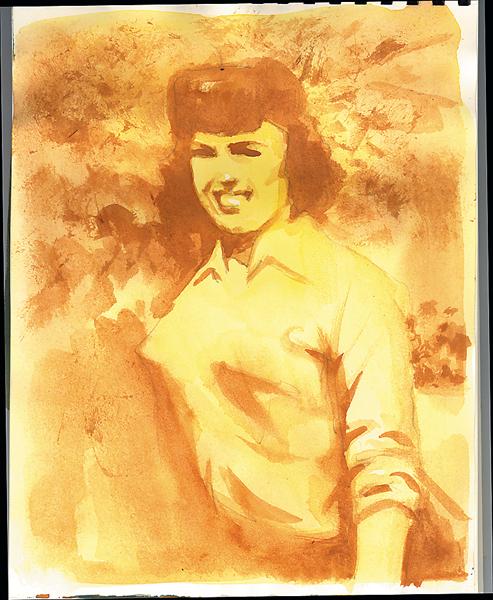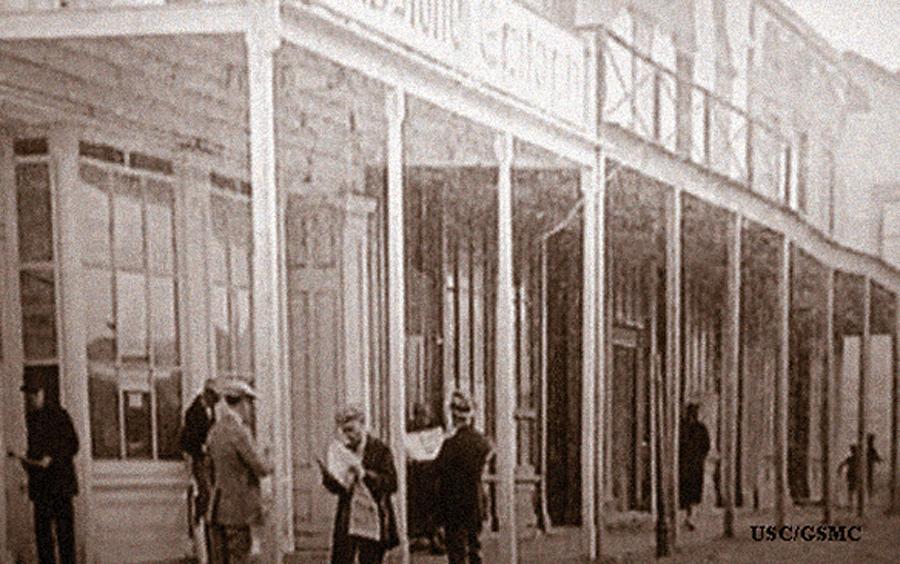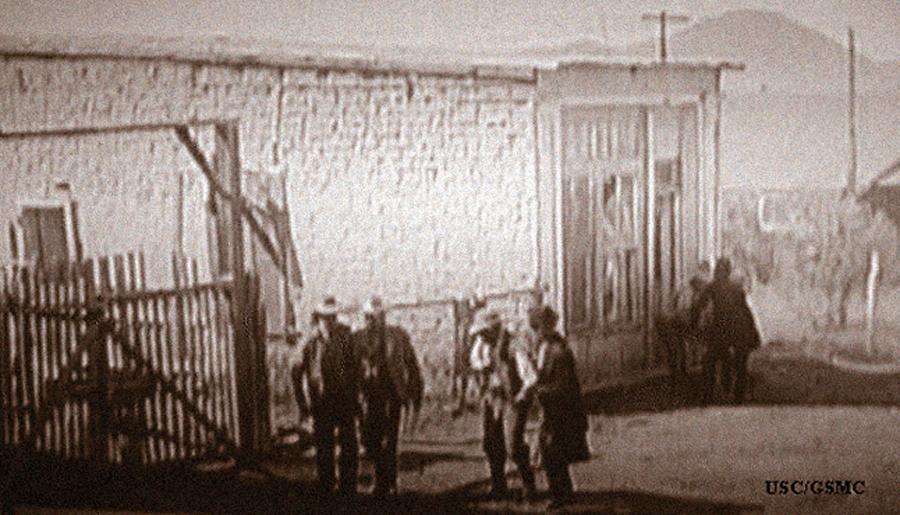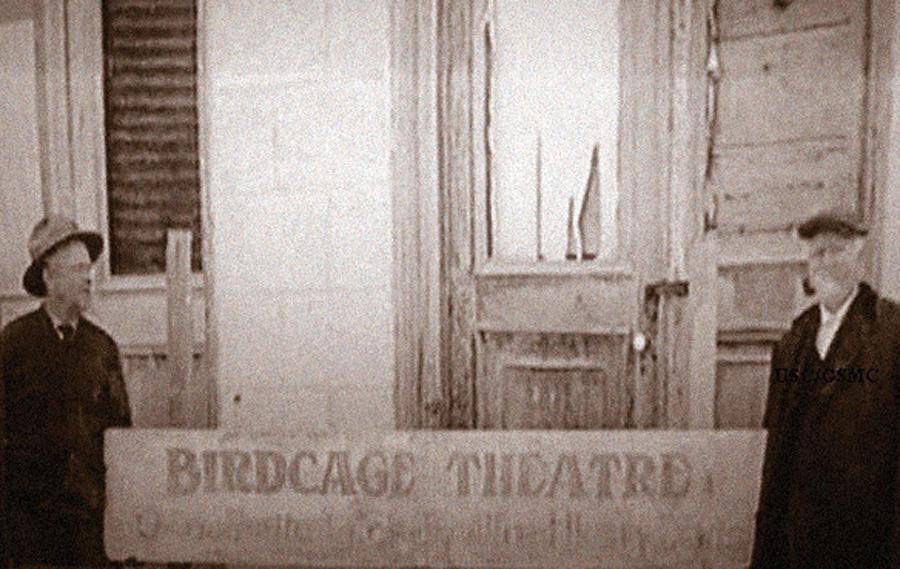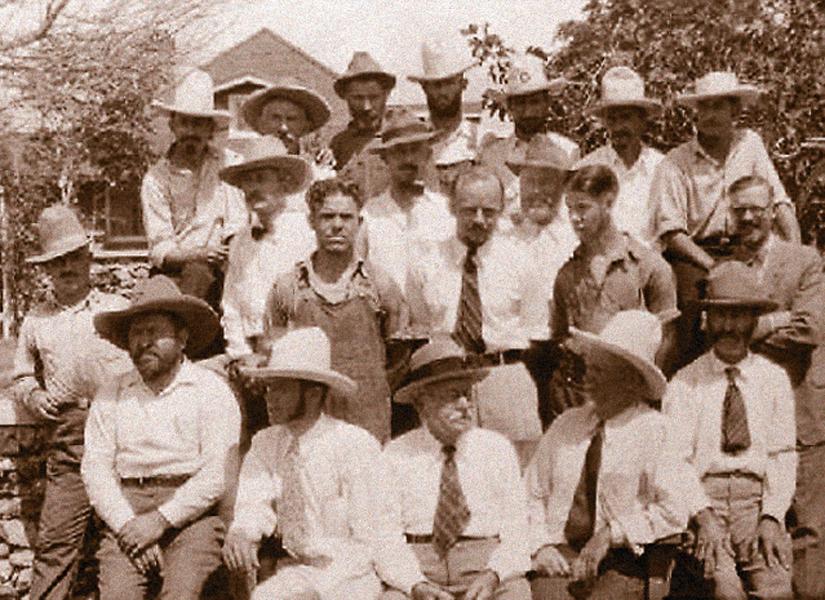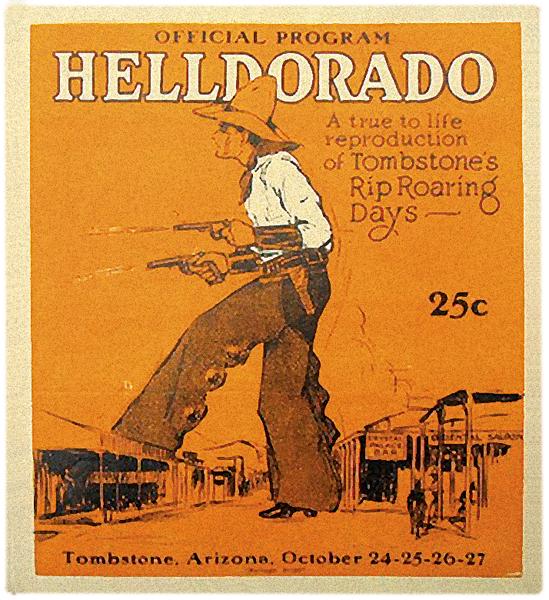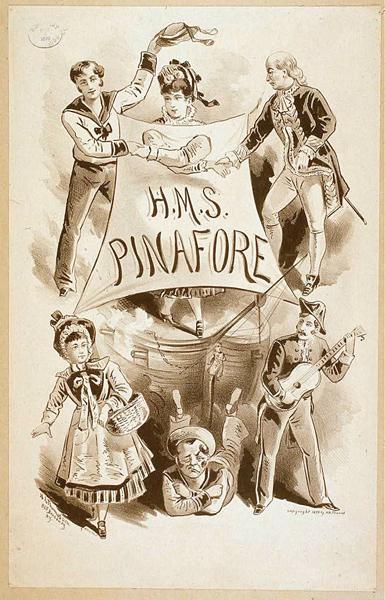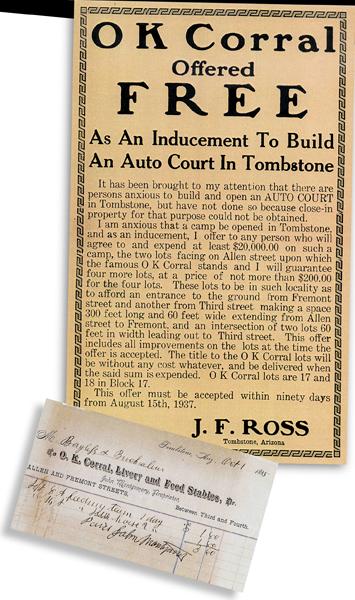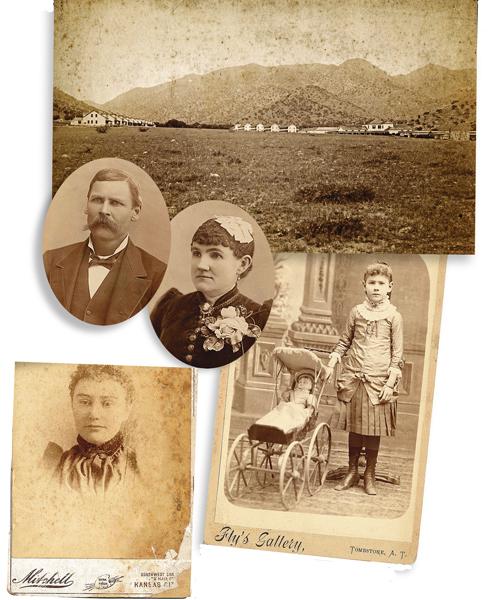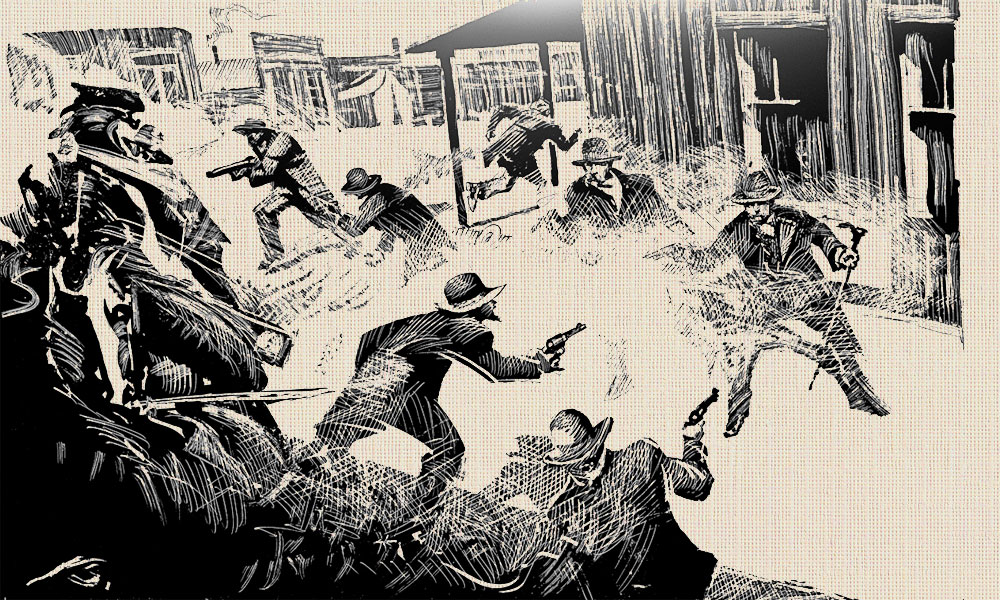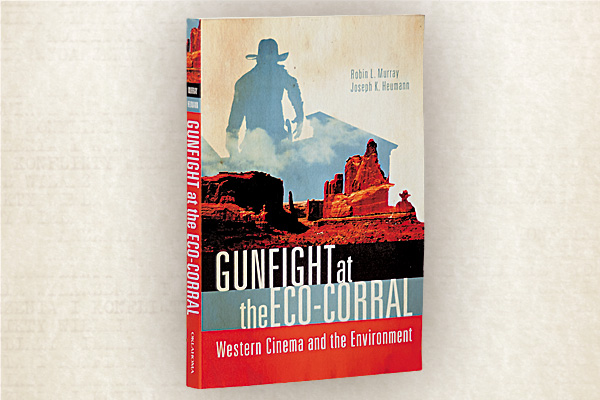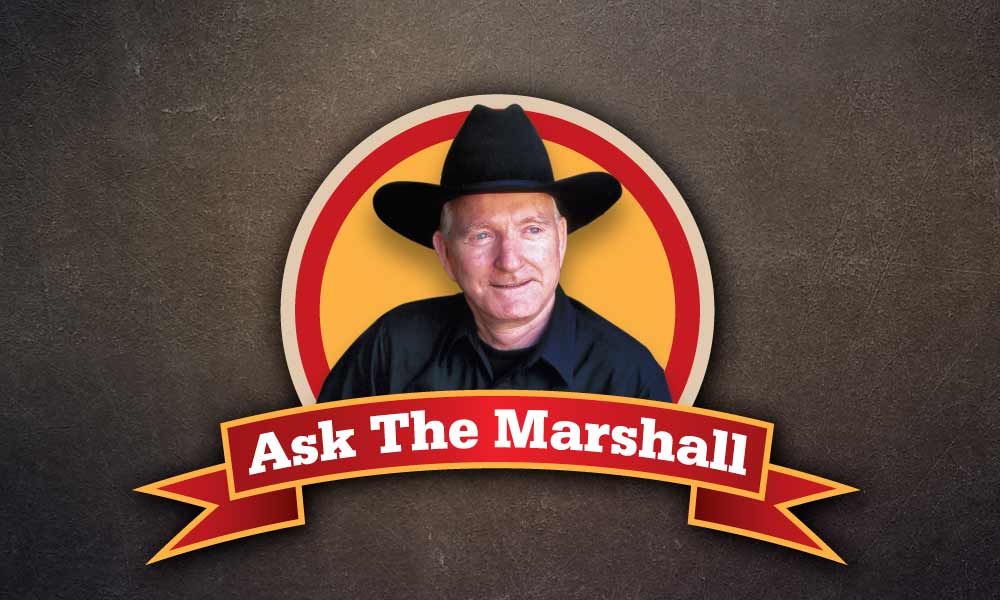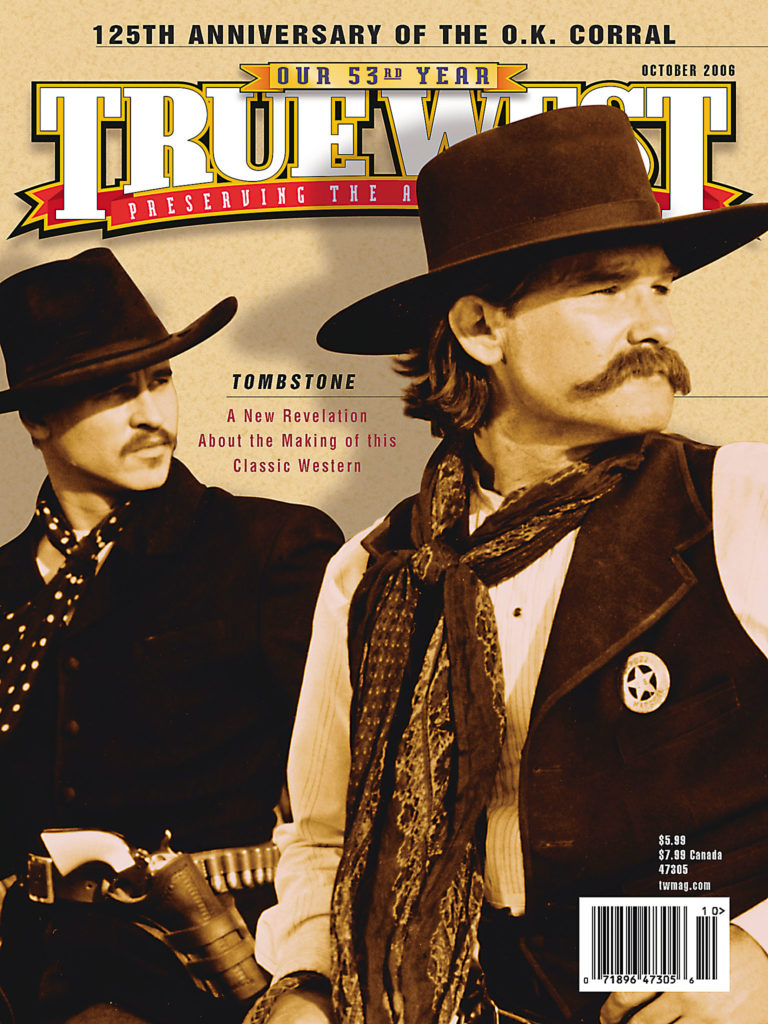 “Boys, you have got to give up your arms.” If the McLaurys and Clantons had heeded Sheriff Johnny Behan’s request, October 26, 1881, would have been just another ordinary day in Tombstone, Arizona.
“Boys, you have got to give up your arms.” If the McLaurys and Clantons had heeded Sheriff Johnny Behan’s request, October 26, 1881, would have been just another ordinary day in Tombstone, Arizona.
But the boys demurred, and the Earps and Doc Holliday brushed past the sheriff, with Wyatt allegedly uttering these famous words: “You sons of bitches, you have been looking for a fight and you can have it.” In the next 27 seconds, eight men create the most defining moment in the history of the Old West.
Tombstone still acknowledges its famous O.K. Corral gunfighters, with the cowboys—Billy Clanton, Ike Clanton, Tom McLaury and Frank McLaury—on one side, and Doc Holliday and the Earp brothers (Wyatt, Morgan and Virgil) on the other. But the city is specially poised this year, as it celebrates the 125th anniversary of the O.K. Corral gunfight. This is one event Old West afficionados won’t want to miss. In this special issue, we share:
• The story behind Helldorado
• Lineup of events for this year’s celebration
• How to perform the famous “Cup-Spinning” scene
• New images of Wyatt and Doc
• International usages of the O.K. Corral
And if you turn back a few pages, you’ll read an exclusive article sharing never-before-told revelations about the 1993 hit movie, Tombstone.
So tell your boss that you’re attending an important “business” seminar, convince your family that this is a dream vacation (it really is!), suck up to your neighbors now so they’ll walk your dogs for you later, do whatever you have to do, just get your trip planned and come join us out there. You’re a daisy if you do!
Helldorado Days
“Don’t you remember that away back there in 1881, when you were mayor, the men seldom grew anything but a mustache, and there was a city ordinance forbidding anyone but a peace officer to carry firearms within the city limits?” “Well, Billy,” John Clum said in 1929, “you must also remember that we were not giving a Helldorado show away back there in 1881.”
John Clum knew what he was talking about—as did his pal, Uncle Billy Fourr. They’d been in Tombstone during the turbulent times of the late 1870s and early 1880s. They’d rubbed elbows with the notables and notorious. They knew the Earps, the Clantons, the McLaurys.
Fourr was an early Arizona pioneer, settling in Oatman in the early 1860s; he fought Indians, owned a ranch and built a toll road, among other things. Clum was mayor of Tombstone, the owner and editor of the Epitaph newspaper and the head of the local vigilance group. He was also a good friend of Wyatt Earp’s. He’d seen the events that led up to the street fight—now commonly known as the Gunfight at the O.K. Corral. And immediately afterward, he brought in wagons to carry away Wyatt’s brothers, Virgil and Morgan Earp, who were both wounded in the battle.
So Fourr and Clum returned to the scene of the crime (or gunfight) in October 1929. The occasion? A celebration of the 50th anniversary of Tombstone’s founding (not too coincidentally, exactly 48 years after the shoot-out). The event was called Helldorado.
The purpose was to bring in tourist bucks to the town, which had struggled ever since the mining boom faded in the late 1880s. Organizers hoped the national publicity and infusion of cash would keep Tombstone afloat. So they spent long hours and much money on sprucing up the old buildings, training actors and re-enactors, planning a big parade and setting up other entertainment for the benefit of the visitors. Huge arches were placed at both ends of Allen Street. Publicity sheets were sent out far and wide—especially on Southern Pacific Railroad passenger cars. And a special train brought in folks from Phoenix, Tucson and points in between.
John Clum estimated that thousands of people attended—and enjoyed themselves, just as he did. He was especially impressed with the ceremony at Tombstone founder Ed Schieffelin’s grave, just outside of town. Also popular—a mock holdup of the Modoc stage, complete with masked robbers, terrified passengers and a hard-charging posse. Clum called it “a bully stunt.”
The biggest event was the grand parade, which featured an Indian band, cowboys, covered wagons, dozens of animals of all sorts and sizes, and plenty of locals dressed in 1880s garb. Clum was part of the procession, serving as the event’s “Honorary Mayor.” Billy Breakenridge, who’d been a deputy under Sheriff Johnny Behan during the tough old days, rode a big horse in his role as “Honorary Sheriff.”
But most folks were there for one thing: the replay of the O.K. Corral fight. Clum’s take—maybe surprisingly, maybe not—was not nearly so positive.
“The mock street battle between the city police and the rustlers was a grim exhibition that should have been omitted,” Clum wrote in the Arizona Historical Review, published in January 1930. “The spectacle of men engaged in mortal combat is repulsive and distressing. It is inconceivable that any normal spectator derived neither pleasure nor benefit from viewing this mock battle. The lamentable clash between the city police and the rustlers on October 26, 1881, occasioned more partisan bitterness than anything else that ever occurred in that community—and traces of that bitterness linger even to this day. There was no justification for the inclusion of that gruesome act in the Helldorado program, and, in my judgment, the mock street fight was reprehensible—even from a Helldorado standpoint.”
For better or worse, the Tombstone town fathers didn’t listen to Clum. Helldorado became an annual event, with the main draw being the gunfight re-enactment. This year, it runs from October 20-22. John Clum would recognize a lot of this year’s planned activities.
The year 2006, however, also happens to be the 125th anniversary of the street fight—and that will be commemorated October 25-28. True West is sponsoring the event, along with Friends of Tombstone and the O.K. Corral. For those of you who are thinking about moseying on down to be part of the fun, here’s the schedule (subject to change).
WEDNESDAY, OCTOBER 25
• 7 PM: The Bella Union hosts a showing of a DVD about movie presentations of the O.K. Corral gunfight, and fast draw expert Jim Dunham does his stuff.
• Through October 28: The art of Thom Ross and Bob Boze Bell is on display at the Bella Union.
THURSDAY, OCTOBER 26
• ALL DAY: Display of Earp artifacts at the Tombstone Courthouse State Park, the largest ever display of its kind.
• 10 AM—True West contributor Henry Beck discusses the making of 1993’s Tombstone—with some surprising behind-the-scenes stories (see p.22 for a sneak preview) at the Bella Union.
• 10:30 AM—Panel discussion at the Bella Union on Wyatt Earp and Tombstone in Film, featuring Paul Hutton, Michael Blake, Shirley Ayn Linder and Jeff Morey.
• 11 AM—2 PM: Re-enactment of events leading up to the gunfight, performed on Allen Street.
• 12—1 PM: Book signing of Bob Boze Bell’s Blaze Away: The 25 Gunfights Behind the O.K. Corral, at the O.K. Corral.
• 2:30 PM—O.K. Corral actors perform the walkdown and street fight, from Allen to Fremont Streets.
• 3 PM—Panel discussion at the Bella Union on Wyatt Earp and Tombstone in Fiction, with authors Bruce Dettman, Randy Lee Eickhoff, Bruce Olds and Jeff Morey.
• 3-5 PM—Continued gunfights at the O.K. Corral.
• 4:45 PM—Panel discussion at the Bella Union on the O.K. Corral gunfight and inquest. Moderated by Allen Barra, the panel speakers include Steve Lubet, Tim Fattig, Robert Palmquist and Jeff Morey.
• 7-10 PM—Faro gambling at the Oriental Saloon.
• 8-10 PM—A performance of H.M.S. Pinafore at Schieffelin Hall. Josie Marcus (later Earp) supposedly performed in the operetta when she first came to Tombstone—supposedly.
• 8:30 PM—Faro demonstration by Sherry Monahan at the Bella Union.
• 9:15 PM—Music by Mark Warren at the Bella Union.
FRIDAY, OCTOBER 27
• 10 AM—Panel at the Bella Union on the Women of the Tombstone Story, with authors Sherry Monahan, Cindy Reidhead, Patrick Bowmaster and Carol Mitchell. Major new findings on Josie Earp will be discussed.
• 10 AM—11:30 PM: Re-enactment of events leading up to the gunfight, performed on Allen Street.
• 12-3:30 PM—More gunfights at the O.K. Corral.
• 12-4 PM—History panels at Schieffelin Hall, featuring numerous experts and authors of Tombstone’s history.
• 2 PM—A Tour of Tombstone with Tim Fattig, author of Wyatt Earp:?The Biography.
• 4:15 PM—The First Annual All-Death Panel—Where They Died, How They Died, and Why People Still Insist They’re Buried Somewhere Else, at the Bella Union. The very alive panel includes Dan Buck (Butch Cassidy and the Sundance Kid expert), T.J. Stiles (Jesse James expert), Tim Fattig (Curly Bill expert), Bob Boze Bell (executive editor of True West magazine) and Michael Wallis (Billy the Kid expert).
• 7-10 PM—Faro gambling at the Oriental Saloon.
• 8 PM—Play faro with Sherry Monahan at the Bella Union, followed by more music from Mark Warren.
• 8-10 PM—H.M.S. Pinafore at Schieffelin Hall.
SATURDAY, OCTOBER 28
• 9 AM: Annual Western Book Exposition at the American Legion Hall Post No. 24 sponsored by Talei Publishers and the Friends of the Elsie Hogan Community Library. Western authors, magazine and newspaper publishers, radio personalities, artists, collectors of rare books, coins, Western memorabilia and museum and historical society exhibitors will sit side-by-side for a “meet and greet.” Some noted historians at this event include Robert DeArment (see p. 56), Leon C. Metz (author of The Encyclopedia
of Lawmen, Outlaws and Gunfighters), Wyatt Earp (a great-nephew to the famous Wyatt Earp) and Steve Gatto (author of Curly Bill:?Tombstone’s Most Famous Outlaw).
• 10 AM—Panel at the Bella Union on the Supporting Actors: The Most Important Role Players in the Tombstone Story. The list includes Sherman McMasters, Endicott Peabody, Buckskin Frank Leslie and John Clum.
• 10:30 AM—Skits on Allen Street.
• 11:45 AM—Author readings at the Bella Union. Paul Cool presents excerpts from his upcoming book on the El Paso Salt War, and Michael Wallis reads from his upcoming book on Billy the Kid.
• 12-1:30 PM—Re-enactment of the McLaury/Clanton funeral procession, featuring authentic 1880s horse-drawn hearses and costumed participants.
• 2-3:30 PM—Continued gunfights at the O.K. Corral.
• 2-5 PM—Book signings in Schieffelin Hall, featuring noted authors in the Western history field, including Steven Lubet (Murder in Tombstone), Jack Burroughs (John Ringo: The Gunfighter Who Never Was), Bob Boze Bell (Blaze Away:?The 25 Gunfights Behind the O.K. Corral), Thom Ross (Gunfight at the O.K. Corral in Words and Pictures), Professor Edward Finn (Legend of the O.K. Corral) and Allen Barra (Inventing Wyatt Earp:?His Life and Many Legends).
• 6-8 PM—Tombstone High School students present a history program at the Tombstone Courthouse State Historic Park.
• 8-10 PM—H.M.S. Pinafore at Schieffelin Hall.
Giving Away the O.K. Corral
To many, the O.K. Corral is hallowed ground, but it certainly hasn’t always been that way. True West reader and Western collector Kevin J. Mulkins couldn’t resist sending along this broadside he recently purchased.
The backstory is that John F. Ross, a Tombstone lawyer and justice of the peace, was so eager to build an auto court that he discounted the potential of the O.K. Corral by offering to give it away in this August 15, 1937, flyer. Ross bought the above described lots in 1934, but it’s unknown if he got any bidders. In the late 1950s, businessman Howard Love finally combined the corral and C.S. Fly’s property, making them tourist draws, which they remain to this day.
Bucking the Tiger: How to Play Faro
First things first—the name of the game is faro. Not pharaoh (although some stories say the two are linked). Not pharo. Faro.
It’s an old game, dating back hundreds of years. The modern version came about during the reign of France’s Louis XIV, during the late 1600s.
And all those shots of poker games featured in numerous Westerns? Nope. Faro was usually the game of choice in saloons and gambling halls. And why not? When it was played straight—or if it was played straight—the player’s odds of winning were almost even with those of the house.
Many of the West’s big names were faro men. Wyatt Earp not only played, but he also ran faro games in several towns. So did Bat Masterson. And Doc Holliday.
By the time of the Depression, faro had lost its appeal. Poker was easier and didn’t require a banker/dealer, so it could be played outside of gaming establishments. Still, for aficionados of the Old West, faro—“bucking the tiger” as it was known—has historic appeal.
Even though most folks don’t know how to play it, Sherry Monahan, author of Taste of Tombstone and The Wicked West, does, and she offers us this rundown for those who want to play at home.
Starting the Game
The dealer’s deck is placed face up on the table. Before any cards are dealt, all bets must be placed by marking one of the spades or a combination of them with a chip or check. When the cards are shuffled and placed face up on the table, the first card appearing is called the ‘soda’ card and is placed in a discard pile. While spades are used on the faro layout, suits are irrelevant in this game and only the denomination matters.
Two Cards Per Round
The soda card is laid to the dealer’s far right and away from the deck. The next card to appear is the losing card, and it’s placed directly next to the deck. The card appearing on the deck is the winning card. (I.e. A player places a chip on the three to win. The dealer’s first card is a king—the losing card. The second card is a four—the winning card. Since the player did not choose the four or the king, he neither wins nor loses.) The dealer collects all bets placed on the losing card and pays any bets on the winning card. That concludes a turn. The winning card now becomes a soda card and is placed in that pile. There is no real end to the game, which can continue indefinitely. If the cards run out, they are shuffled so that play resumes.
Paying Out Bets
Bets are paid dollar for dollar, so if you bet one dollar, you get one back. Whenever the winning and losing cards are of the same value (i.e., a six and a six), or if the player has wagered the same bet on two cards, then the dealer only takes half of the bet. If the amount cannot be divided evenly, then the difference belongs to the dealer.
Copper Bets
If a player thinks a certain card will lose, he can “copper” his stack of chips, which indicates he is betting to lose. To copper, place a penny on the bet covering the card to lose. A player may place a copper on his $1 bet covering the king. The dealer turns the first card, a king, which is the losing card. Since the player chose the king to lose, he wins the bet.
Split Bets
Bets can be placed in different positions on the layout, and the way they are placed determines how the hand goes. If a player puts a stack of chips between the king and queen (or any other two cards) and puts a “copper” on the king, he bets the king will lose and queen will win. If the cards come out and both are against him, he is “whip-sawed” on the turn and loses. Bets can also be placed behind three cards, on the corners between two or in any position that will take in the combinations that are allowed in the game.
Calling the Turn
In addition to the regular bets, players have the choice of “calling the turn” when the last three cards are left (there are actually four cards left, but the top card will be discarded as the soda). A player can guess in which order the last three cards will be dealt (there are six possible combinations). Once bets are placed (which should be easy if players have kept track of the cards already played), a player can call the turn. If successful, he is paid four to one; if not, he loses. If two of the last three cards are the same (i.e., two fives and one Jack appear), it’s called a cat-hop, and the dealer pays two to one.
You can see “Bucking the Tiger” in action at this year’s 125th Anniversary of the O.K. Corral celebration. Sherry Monahan will give a faro demonstration at the Bella Union at 8:30 p.m. on October 26.
VIP TICKET HOLDERS
In addition, organizers of the celebration are offering “VIP”-only events. The tickets are $125, and they allow purchasers unlimited entrance to the O.K. Corral, the Bird Cage Theatre, the office of The Tombstone Epitaph, the Tombstone Courthouse State Park, the Rose Tree Museum and the Western Heritage Museum. The VIP tickets were almost sold out as of press time, so order yours quickly at www.okcorralgunfight.com or 800-457-3423. Other events for “VIP” ticket holders:
• Wednesday, Oct. 25: A behind-the-scenes tour of the Bird Cage Theatre between 5 and 7 p.m.; and at 6 p.m., a welcome party at the Depot Steak House.
• Thursday, Oct. 26: From 5 to 7 p.m., a behind-the-scenes tour of the Tombstone Courthouse State Park; at 6 p.m., a reception at Six-Gun City; and at 8:30 p.m., a Ghost Gunfight at the O.K. Corral (a nighttime re-enactment of the gunfight).
• Friday, Oct. 27: From 11 a.m. to 2 p.m., guided tours of the Tombstone Pioneer House; 5 to 7 p.m., a behind-the-scenes tour of the O.K. Corral; and 5 to 8 p.m., a BBQ dinner at the Depot Steak House for those who didn’t use the dinner ticket at the Wednesday event.
• Saturday, Oct. 28: From 7 to 10 p.m., a Dance Hall and Gaming Night at the Bella Union.
For those without VIP tickets, here are the regular admission prices to enter the sites: O.K. Corral ($7.50, which includes admission to the 2 p.m. gunfight; $5.50 without the gunfight); Bird Cage Theatre ($8 adults, $7 seniors, $6 for kids up to 18); Office of the Epitaph (FREE); Tombstone Courthouse State Historic Park ($4; kids under 12 are free); Rose Tree Museum ($3); and the Western Heritage Museum ($5 adults, $3 youth 12-18, under 12 are free). Descriptions of what you can find at each of these attractions are below.
Tombstone Courthouse State Historic Park
The 1882 building looks pretty much the way it did during Tombstone’s heyday—the courtroom, lawyer’s office and assay office are pristine. Inside, you’ll find history exhibits, photographs and, for researchers, extensive archives to find firsthand information.
Rose Tree Museum and Bookstore
The big attraction—and we mean big—is an 8,700-foot rose tree that arrived back in 1885. For the non-plant lover, there’s also historical photos and antique furnishings owned by a brave soul who came to Tombstone in 1880.
Birdcage Theatre
The legendary saloon/theatre/brothel opened just a couple of months after the O.K. Corral battle, then stayed open 24/7 for the next eight years. The place hasn’t changed much, showing off old bottles, bullet holes and an 1880s hearse that carried most of the town’s dearly departed to their final resting place.
O.K. Corral
The place, of course, where the gunfight took place. A re-enactment is held each day at two in the afternoon. Visitors may also see old stables, carriages, a hearse and a prostitute’s shack. A Historama show re-creates old happenings with movies and animated figures.
Western Heritage Museum
One of the newer museums in town, this one features photos, documents and guns from the Old West period—including some items owned by Virgil and Wyatt Earp.
The Tombstone Epitaph Office
John Clum started the paper in 1880, and it’s still in business. The original press is there, along with a number of exhibits about printing in the Old West. And you can get your own copy of the paper, to boot.
Photo Gallery
Which book is best? That depends….
– True West Archives –
Back in the 1930s, the widow of Wyatt Earp went out to lunch with a young relative in southern California. It was a memorable meal.
Josie Earp loudly complained about everything—including the water. Her teenage companion was mortified by the whole ordeal. And yet, in her later years, Jeanne Cason Laing—the girl in the story—would remember Josie with fondness. She was one of the few to do so.
That same disagreeable nature brought Josie to Jeanne. The old woman was not happy with Stuart Lake’s book Wyatt Earp: Frontier Marshal, which came out in 1931. She decided to tell the story herself, and started looking for somebody to help. She found two Earp cousins, Mabel Cason and Vinnolia Ackerman, who were both writers. They signed up for the project.
Josie was destitute, so she spent time living in the Cason and Ackerman households. Her volatile temper kept everyone on edge, as Jeanne Laing recalled. In one instance, Josie and Jeanne were at a train station, and the old lady gave the ticket agent her calling card: “Mrs. Wyatt Earp.” The agent asked, “Is that two-gun Wyatt?” and Josie blew up at him, demanding more respect for the dead lawman and her.
Ultimately, her cousins came up with Josie’s story—the so-called Cason Manuscript. Predictably, Josie didn’t like it. It was never formally published. Josie passed away in 1944 at the age of 83.
Jeanne Cason Laing became a medical technician and nurse, dedicating her life to helping others. She also offered plenty of assistance to folks who had questions about Josie Earp (and hence about Wyatt), sharing her memories with one and all. She was as likeable as Josie was, uh, difficult.
Jeanne passed away in southern California on May 22, 2006, at the age of 85, closing the book on a remarkable life. And with her death goes another direct link to the Old West.
At last year’s Helldorado Days, researcher Gary McLelland shared a recent discovery of his: two newsreels depicting “The Lost Streets of Tombstone.” Clips from these newsreels are shown below; they were originally shot in 1925 and 1929, right around the time Walter Noble Burns’ Tombstone book came out, attracting global interest in the “town too tough to die.”
Above is the Gird Block, which housed the offices for the Tombstone Mining Exchange and The Tombstone Epitaph.
– Courtesy Gary McLelland –
The above shot reveals that the 1920s’ re-enactment of the Earp-Clanton gunfight at the rear entrance to the O.K. Corral was 50 yards off.
– Courtesy Gary McLelland –
You can see for yourself what the streets of Tombstone looked like in the 1920s. Visit oldwesthistory.net and order the DVD ($14.99).
– Courtesy Gary McLelland –
– Courtesy Gary McLelland –
– Courtesy Gary McLelland –
H.M.S. Pinafore: Big Entertainment in the Old West.
Gilbert and Sullivan’s operetta made its debut in London in May 1878. Within a couple of years, it had become so popular that acting companies around the world were presenting it—usually without asking permission first. That was probably the case with the company that visited Tombstone in the 1880s.
The plot is a little convoluted.
Ralph, a common sailor aboard Her Majesty’s ship Pinafore, is in love with Captain Corcoran’s daughter, Josephine. But the captain has promised her to his boss, Admiral Joseph Porter. A woman who sells sundry goods to the sailors—Little Buttercup (you can’t make this stuff up)—has an eye for the captain. But because she’s lower class, he doesn’t give her a second thought.
Skipping a few pages…and songs….
In spite of their class differences, Josephine and Ralph finally get together and decide to elope. They’re caught by her father and the admiral. Ralph is sent to the brig. But then comes the big finale.
Little Buttercup reveals a secret—that the captain and Ralph were switched when they were babies. So Ralph becomes the captain, and Corcoran downgrades to a deckhand. Now Ralph and Josephine can marry. The ex-captain sees Little Buttercup in a new light and decides to accompany her to the altar. The admiral falls for his cousin, who has been making eyes at him throughout the play. And the crew loves the ship. End of story.
Sort of. Legend has it that Josie Earp first came to Tombstone with a company performing “H.M.S. Pinafore.” But that may be just as made up as the name “Little Buttercup.”
Oh, and a pinafore? It’s a girl’s jumper, a sleeveless dress worn over other clothing. Gilbert and Sullivan were having a little joke by naming a ship after the apparel. (You had to be there….)
– Courtesy Robert G. McCubbin –
Among the display of Earp artifacts at the Tombstone Courthouse State Park will be historical photographs of Old Tombstone. Included in this exhibit are (top) Fort Huachuca; (middle) C.S. Fly photographs of Ben Goodrich, his wife Mary and their daughter with her doll and carriage. Ben Goodrich was the lawyer who helped prosecute Wyatt Earp and Doc Holliday; (bottom) Urilla Sutherland, Wyatt’s first wife.
– Courtesy Bob Love –



